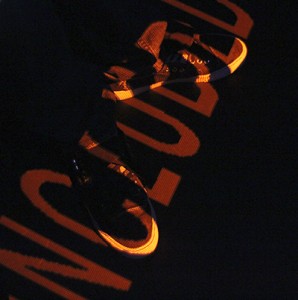Justin Botz’ sketch used interactive text from two interviews with artists Meredith Monk and Pauline Oliveros.
On October 30 Annette Barbier’s Visual Environments class (click here for the class blog) gathered to present sketch installations. Visual Environments addresses the creation of artworks that exist in conjunction with their surroundings as opposed to being self-contained. The class investigates such concepts as: scale, duration, durability, sustainability, participation, and uses methods and media that include sound, projection, light, and both traditional and DIY materials. The sketches presented this week required a response element from the audience such as a movement, sound making, or change of posture.
Tom Ruiz used “MaKey MaKey” hardware that created visuals responsive to different blocks placed on a pedestal.
The InterArts MFA students at Columbia are known for creating a diverse body of work using a wide variety of materials and involving considerable research and conceptual development. The students in this semester’s Visual Environments class are second-year students in a three-year program that provides a solid technical foundation to create advanced contemporary work.
Darren Lorenzi’s work brought the observer to a live capture camera and a mic that created visuals reacting to clarity of communication.
For the explorative installations presented this week, students combined traditional fine art elements with current technologies. Max/MSP/Jitter, Isadora, and Processing (a java-based language used by many artists), were the primary software environments used by students to execute the response elements of the various works. Performance and interaction with the observer were a possible element of the installations, although students also created stand-alone projects that had interactive sound and/or visuals. Locations included the Raw Space, both the white and black installation rooms, the grad student studios, and a back alley.
Sid Branca‘s interactive performance explored longing, desperation, Americana, the relationship between blues music and theater.
After presenting the each work, the class engaged in feedback that included suggestions for improvement as well as kudos for successful elements of the project. The students produce five sketch installations for the class, and collaboration and support – hallmarks of the InterArts program – are clearly seen in the works by these dedicated and inventive students.





